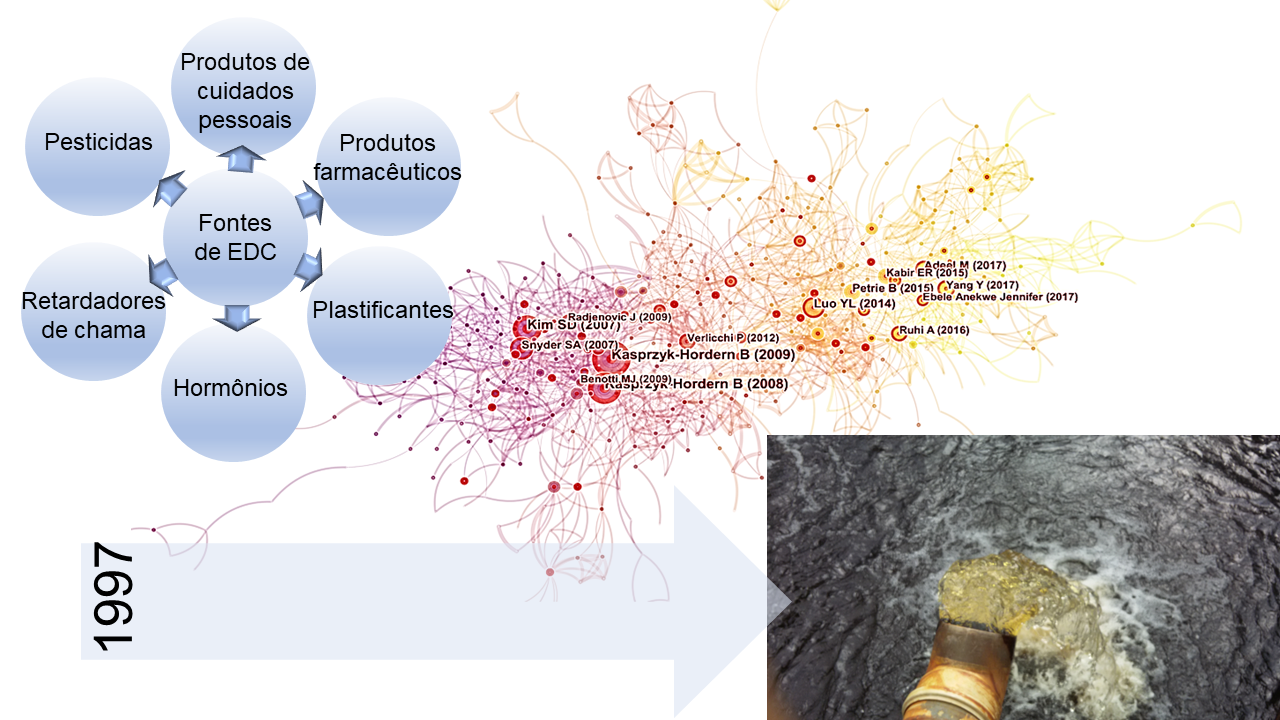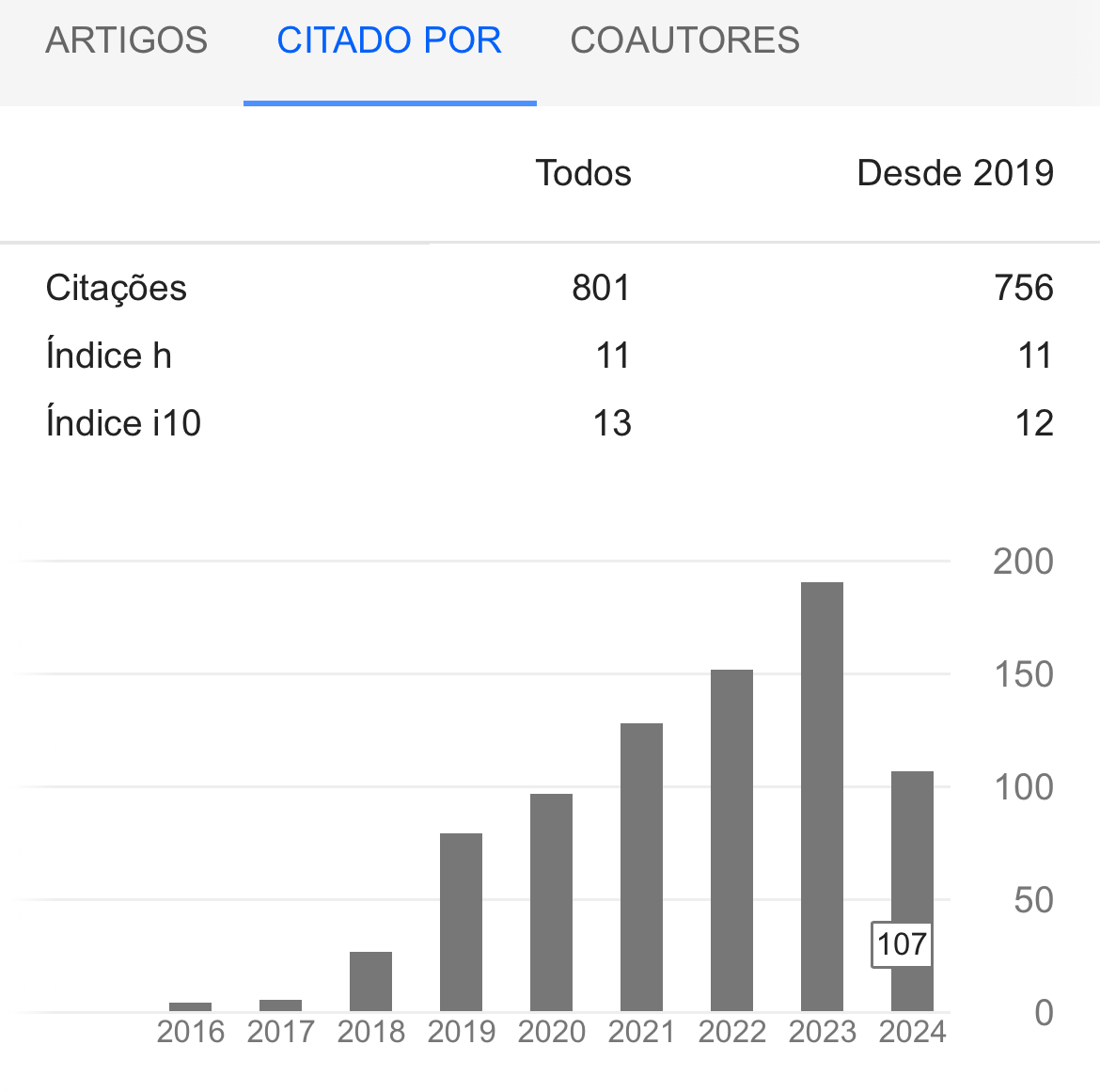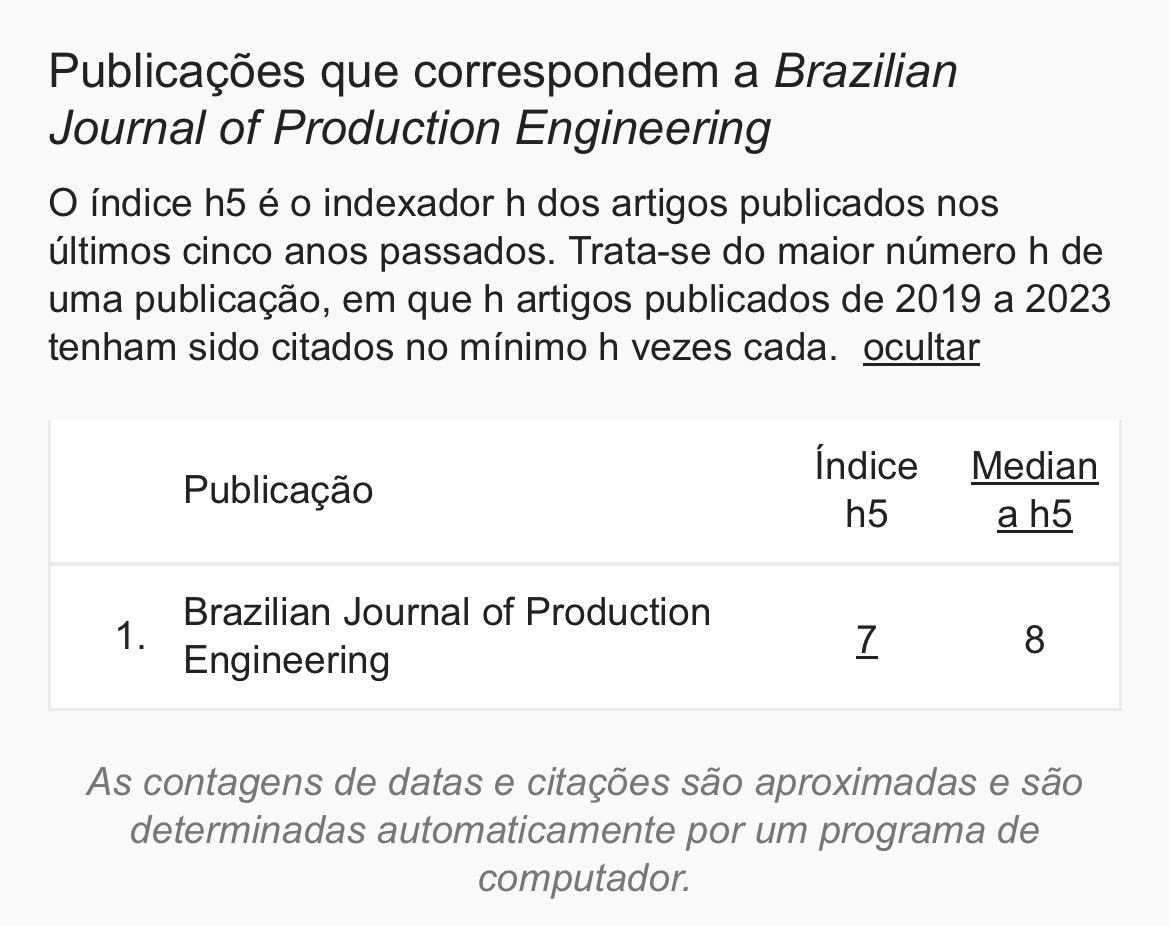Compuestos disruptores endocrinos en agua: una perspectiva bibliométrica
DOI:
https://doi.org/10.47456/bjpe.v8i3.37988Palabras clave:
Disruptores endocrinos, agua, bibliometríaResumen
El propósito de este artículo es investigar la evolución de los estudios científicos sobre los compuestos disruptores endocrinos en el agua. Se realizó un estudio bibliométrico utilizando el software Citespace y la base de datos Web of Sience, desde 1945 hasta 2021. Se eligió el período de mayor producción de artículos (2010 a 2021) con 1624 artículos para componer la base de datos. Se utilizó el software Citespace para analizar las publicaciones, países, instituciones, autores y palabras clave más relevantes. Los resultados mostraron que China y Estados Unidos contribuyeron con el 17,4% y el 16,5% de las publicaciones, respectivamente. Los estudios sobre los disruptores endocrinos en el agua son multidisciplinarios y abarcan la ecología desde las ciencias ambientales, la química, la ingeniería, la toxicología, entre otros campos. Publicaciones periódicas como Environmental Science Technology, Chemosphere, Science of the Total Environmental, Water research fueron las principales fuentes de los trabajos citados. Los resultados mostraron que las palabras clave “hormona”, “ácido”, “expresión” y “metabolito representan tendencias emergentes. Concluimos que los disruptores endocrinos pueden representar un desafío y una oportunidad para desarrollar metodologías para mitigar estos contaminantes emergentes en el agua natural.
Descargas
Citas
Baker, D. R., & Kasprzyk-Hordern, B. (2013). Spatial and temporal occurrence of pharmaceuticals and illicit drugs in the aqueous environment and during wastewater treatment: new developments. The Science of the total environment, 454-455, 442–456. https://doi.org/10.1016/j.scitotenv.2013.03.043
Benotti, M. J., Trenholm, R. A., Vanderford, B. J., Holady, J. C., Stanford, B. D., & Snyder, S. A. (2009). Pharmaceuticals and endocrine disrupting compounds in U.S. drinking water. Environmental science & technology, 43(3), 597–603. https://doi.org/10.1021/es801845a
Benvenga, S., Elia, G., Ragusa, F., Paparo, S. R., Sturniolo, M. M., Ferrari, S. M., Antonelli, A., & Fallahi, P. (2020). Endocrine disruptors and thyroid autoimmunity. Best practice & research. Clinical endocrinology & metabolism, 34(1), 101377. https://doi.org/10.1016/j.beem.2020.101377
Brasil. Conselho Nacional de Meio Ambiente – CONAMA. Resolução n.º 430, de 13 de maio de 2011. Diário Oficial da União N° 92 Página 89, Brasília, 2011a.
Brasil. Ministério da Saúde. Portaria n.º 888, de 04 de maio de 2021. Procedimentos de controle e de vigilância da qualidade da água para consumo humano e seu padrão de potabilidade. Diário Oficial da União. Edição 85 Seção 1 Página 127.Brasília, 2011b.
Browne, P., Noyes, P. D., Casey, W. M., & Dix, D. J. (2017). Application of Adverse Outcome Pathways to U.S. EPA's Endocrine Disruptor Screening Program. Environmental health perspectives, 125(9), 096001. https://doi.org/10.1289/EHP1304
Castiglioni, S., Bagnati, R., Fanelli, R., Pomati, F., Calamari, D., & Zuccato, E. (2006). Removal of pharmaceuticals in sewage treatment plants in Italy. Environmental science & technology, 40(1), 357–363. https://doi.org/10.1021/es050991m
Castillo, M. & Barceló, D. (1997). Analysis of industrial effluents to determine endocrine-disrupting chemicals, TrAC Trends in Analytical Chemistry, 16(10), 574-583, 1997. https://doi.org/10.1016/S0165-9936(97)00090-3
Chen, C. (2006). CiteSpace II: Detecting and visualizing emerging trends and transient patterns in scientific literature. Journal of the American Society for Information Science and Technology, 57(3), 359-377. https://doi.org/10.1002/asi.20317
EPA (1997). Special Report on Environmental Endocrine Disruption: An Effects Assessment and Analisys, U.S. Environmental Protection Agency, Report No. EPA/630/R-96/012, Washington, DC., 111p.
Fu, H. Z., Wang, M. H., & Ho, Y. S. (2013). Mapping of drinking water research: a bibliometric analysis of research output during 1992-2011. The Science of the total environment, 443, 757-765. https://doi.org/10.1016/j.scitotenv.2012.11.061
Gonsioroski, A., Mourikes, V. E., & Flaws, J. A. (2020). Endocrine Disruptors in Water and Their Effects on the Reproductive System. International journal of molecular sciences, 21(6), 1929. https://doi.org/10.3390/ijms21061929
Gorga, M., Petrovic, M., & Barceló, D. (2013). Multi-residue analytical method for the determination of endocrine disruptors and related compounds in river and waste water using dual column liquid chromatography switching system coupled to mass spectrometry. Journal of chromatography. A, 1295, 57–66. https://doi.org/10.1016/j.chroma.2013.04.028
Huerta, B., Jakimska, A., Gros, M., Rodríguez-Mozaz, S., & Barceló, D. (2013). Analysis of multi-class pharmaceuticals in fish tissues by ultra-high-performance liquid chromatography tandem mass spectrometry. Journal of chromatography. A, 1288, 63–72. https://doi.org/10.1016/j.chroma.2013.03.001
Jardim, W. F., Montagner, C. C., Pescara, I. C., Umbuzeiro, G. A., Bergamasco, A. M. D., Eldridge, M. L. & Sodré, F. F. (2012). An integrated approach to evaluate emerging contaminants in drinking water. Separation and Purification Technology, 84, 3-8. https://doi.org/10.1016/j.seppur.2011.06.020.
Kabir, E. R., Rahman, M. S., & Rahman, I. (2015). A review on endocrine disruptors and their possible impacts on human health. Environmental toxicology and pharmacology, 40(1), 241-258. https://doi.org/10.1016/j.etap.2015.06.009
Kasprzyk-Hordern, B., Dinsdale, R. M., & Guwy, A. J. (2008). The occurrence of pharmaceuticals, personal care products, endocrine disruptors and illicit drugs in surface water in South Wales, UK. Water research, 42(13), 3498–3518. https://doi.org/10.1016/j.watres.2008.04.026
Kasprzyk-Hordern, B., Dinsdale, R. M., & Guwy, A. J. (2009). The removal of pharmaceuticals, personal care products, endocrine disruptors and illicit drugs during wastewater treatment and its impact on the quality of receiving waters. Water research, 43(2), 363-380. https://doi.org/10.1016/j.watres.2008.10.047
Kavlock, R. J., Daston, G. P., DeRosa, C., Fenner-Crisp, P., Gray, L. E., Kaattari, S., Lucier, G., Luster, M., Mac, M. J., Maczka, C., Miller, R., Moore, J., Rolland, R., Scott, G., Sheehan, D. M., Sinks, T., & Tilson, H. A. (1996). Research needs for the risk assessment of health and environmental effects of endocrine disruptors: a report of the U.S. EPA-sponsored workshop. Environmental health perspectives, 104 Suppl 4(Suppl 4), 715-740. https://doi.org/10.1289/ehp.96104s4715
Kim, S. D., Cho, J., Kim, I. S., Vanderford, B. J., & Snyder, S. A. (2007). Occurrence and removal of pharmaceuticals and endocrine disruptors in South Korean surface, drinking, and waste waters. Water research, 41(5), 1013-1021. https://doi.org/10.1016/j.watres.2006.06.034
Kosma, C. I., Lambropoulou, D. A., & Albanis, T. A. (2014). Investigation of PPCPs in wastewater treatment plants in Greece: occurrence, removal and environmental risk assessment. The Science of the total environment, 466-467, 421–438. https://doi.org/10.1016/j.scitotenv.2013.07.044
Lima, D. R. S., Tonucci, M. C., Libânio, M.& Aquino, S. F., (2017) Fármacos e compostos desreguladores endócrinos em águas brasileiras: ocorrência e técnicas de remoção. Engenharia Sanitária e Ambiental. 22(06), 1043-1054. https://doi.org/10.1590/S1413-41522017165207
Lu, J., Zhang, C., Wu, J., Zhang, Y., & Lin, Y. (2020). Seasonal distribution, risks, and sources of endocrine disrupting chemicals in coastal waters: Will these emerging contaminants pose potential risks in marine environment at continental-scale? Chemosphere, 247, 125907. https://doi.org/10.1016/j.chemosphere.2020.125907
Margina, D., Nițulescu, G. M., Ungurianu, A., Mesnage, R., Goumenou, M., Sarigiannis, D. A., Aschner, M., Spandidos, D. A., Renieri, E. A., Hernández, A. F., & Tsatsakis, A. (2019). Overview of the effects of chemical mixtures with endocrine disrupting activity in the context of real-life risk simulation: An integrative approach (Review). World Academy of Sciences journal, 1(4), 157–164. https://doi.org/10.3892/wasj.2019.17
Montagner, C. C. & Jardim, W. F. (2011). Spatial and seasonal variations of pharmaceuticals and endocrine disruptors in the Atibaia River, São Paulo State (Brazil). Journal of the Brazilian Chemical Society, 22(8), 1452-1462. https://doi.org/10.1590/S0103-50532011000800008
Moreira, D. S., Aquino, S. F., Afonso, R. J., Santos, E. P., & de Pádua, V. L. (2009). Occurrence of endocrine disrupting compounds in water sources of Belo Horizonte Metropolitan Area, Brazil. Environmental technology, 30(10), 1041–1049. https://doi.org/10.1080/09593330903052830
Olea, N., Pazos, P., & Exposito, J. (1998). Inadvertent exposure to xenoestrogens. European journal of cancer prevention: the official journal of the European Cancer Prevention Organisation (ECP), 7 Suppl 1, S17–S23. https://doi.org/10.1097/00008469-199802001-00005
Ponnuchamy, M., Kapoor, A., Senthil Kumar, P., Vo, D. N., Balakrishnan, A., Jacob, M. M., & Sivaraman, P. (2021). Sustainable adsorbents for the removal of pesticides from water: a review. Environmental Chemistry Letters. 19, 2425-2463. https://doi.org/10.1007/s10311-021-01183-1
Radjenović, J., Petrović, M., & Barceló, D. (2009). Fate and distribution of pharmaceuticals in wastewater and sewage sludge of the conventional activated sludge (CAS) and advanced membrane bioreactor (MBR) treatment. Water research, 43(3), 831-841. https://doi.org/10.1016/j.watres.2008.11.043
Ruhi, A., Acuña, V., Barceló, D., Huerta, B., Mor, J. R., Rodríguez-Mozaz, S., & Sabater, S. (2016). Bioaccumulation and trophic magnification of pharmaceuticals and endocrine disruptors in a Mediterranean river food web. The Science of the total environment, 540, 250-259. https://doi.org/10.1016/j.scitotenv.2015.06.009
Rathi, B. S., Kumar, P. S., & Show, P. L. (2021). A review on effective removal of emerging contaminants from aquatic systems: Current trends and scope for further research. Journal of hazardous materials, 409, 124413. https://doi.org/10.1016/j.jhazmat.2020.124413
Russo, G., Laneri, S., Di Lorenzo, R., Ferrara, L., & Grumetto, L. (2021). The occurrence of selected endocrine-disrupting chemicals in water and sediments from an urban lagoon in Southern Italy. Water environment research: a research publication of the Water Environment Federation, 93(10), 1944-1958. https://doi.org/10.1002/wer.1566
Stahlschmidt-Allner, P., Allner, B., Römbke, J., & Knacker, T. (1997). Endocrine disrupters in the aquatic environment. Environmental science and pollution research international, 4(3), 155–162. https://doi.org/10.1007/BF02986325
Sui, Q., Huang, J., Deng, S., Chen, W., & Yu, G. (2011). Seasonal variation in the occurrence and removal of pharmaceuticals and personal care products in different biological wastewater treatment processes. Environmental science & technology, 45(8), 3341-3348. https://doi.org/10.1021/es200248d
Vieira, W. T., Farias, M. B., Spaolonzi, M. P., Silva, M. G. C. & Vieira, M. G. A., (2021). Endocrine-disrupting compounds: Occurrence, detection methods, effects and promising treatment pathways—A critical review, Journal of Environmental Chemical Engineering, 9(1), 104558. https://doi.org/10.1016/j.jece.2020.104558
vom Saal, F. S., Cooke, P. S., Buchanan, D. L., Palanza, P., Thayer, K. A., Nagel, S. C., Parmigiani, S., & Welshons, W. V. (1998). A physiologically based approach to the study of bisphenol A and other estrogenic chemicals on the size of reproductive organs, daily sperm production, and behavior. Toxicology and industrial health, 14(1-2), 239-260. https://doi.org/10.1177/074823379801400115
Wu J. (2020). Challenges for Safe and Healthy Drinking Water in China. Current environmental health reports, 7(3), 292-302. https://doi.org/10.1007/s40572-020-00274-5

Publicado
Cómo citar
Número
Sección
Licencia
Derechos de autor 2022 Brazilian Journal of Production Engineering

Esta obra está bajo una licencia internacional Creative Commons Atribución-NoComercial-CompartirIgual 4.0.











































































